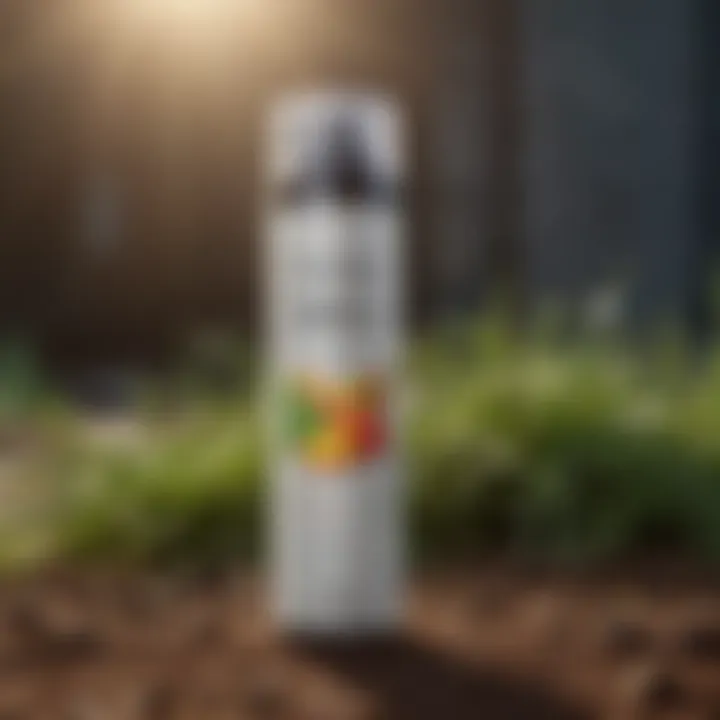Understanding Celsius Yard Spray: Applications and Implications


Intro
Celsius yard spray has become a topic of interest within the agricultural community. This product targets pest management while also promoting ecological sustainability. As agriculture faces challenges like climate change and increasing pest resistance, understanding such tactical approaches can provide valuable insights. This article provides a comprehensive overview of Celsius yard spray, discussing its formulation, applications, and implications for crop management.
Overview of the Topic
Definition and Importance
Celsius yard spray is a tactical formulation designed for use in agricultural settings. Its primary function is to control pests that threaten crop health. Utilizing a product like this is crucial not only for protecting yields but also for maintaining a sustainable ecosystem. The herbicides and pesticides in such sprays are designed to be effective while minimizing harm to beneficial insects and other non-target species.
Current Trends
Recent trends show an increasing focus on sustainable agriculture. Farmers are looking for methods that do not solely rely on synthetic chemicals. Celsius yard spray is aligned with this trend due to its effectiveness combined with less environmental impact. Research highlights how integrated pest management systems improve when Celsius yard spray is utilized. This could lead to reduced reliance on traditional pesticides, further promoting an ecological approach to farming.
Key Techniques and Practices
Step-by-Step Guide
- Identify Pest Problems: Before application, farmers need to monitor their crops for pest infestations.
- Select the Appropriate Formula: Depending on the pest types, choose the right Celsius yard spray formulation.
- Prepare Application Equipment: Ensure equipment is clean and ready for an even spray. A backpack sprayer or hand-held sprayer may be effective.
- Application Timing: Apply during cool parts of the day to prevent evaporative loss and increase effectiveness.
- Post-Application Monitoring: After applying, observe the crops regularly to gauge efficacy and adjust management practices as necessary.
Tools and Equipment Needed
- Sprayers: Utilize either manual or motorized sprayers for application.
- Protective Gear: Use gloves, masks, and glasses to ensure safety during application.
- Measuring Tools: Proper measurement tools are necessary to mix solutions accurately.
- Soil Moisture Sensors (optional): To monitor conditions before and after application, ensuring maximum efficacy.
Challenges and Solutions
Common Obstacles
Several obstacles can affect the deployment of Celsius yard spray. Farmers might face resistance from pests, improper application techniques, or even environmental factors like wind or rain affecting the spray efficacy. Additionally, misunderstandings about the product can lead to over-application, causing potential harm.
Innovative Solutions
To address these common challenges:
- Education: Continuous learning through workshops and extension services can help farmers better understand effective usage.
- Technology: Employing precision agriculture tools can minimize waste and improve targeting of the sprays. Utilizing apps to monitor pest populations can aid in timely and effective application.
- Research Collaborations: Working with agricultural universities can foster innovations in sustainable pest management techniques.
Ultimately, understanding and correctly implementing Celsius yard spray can significantly impact crop health while promoting environmentally responsible farming practices.
Through this exploration of Celsius yard spray's applications and implications, it becomes clear that while challenges exist, the potential benefits are substantial. Integrated into a broader sustainable approach, it can enhance productivity and resilience in agricultural practices.
Prolusion to Celsius Yard Spray
Celsius Yard Spray plays a vital role in modern agricultural practices. Understanding its applications and implications is essential for farmers and agricultural enthusiasts who wish to enhance crop yield while managing pests efficiently. This section explores the definition, purpose, and historical context of Celsius Yard Spray, offering insights into its significance in today’s agricultural landscape.
Definition and Purpose
Celsius Yard Spray is a selective herbicide primarily used to manage weeds in warm-season turfgrass. The main purpose is to control specific types of weeds without damaging the surrounding grass. This selective capability is crucial for maintaining healthy lawns and agricultural fields, promoting optimal growth of desired plants.
The formulation helps in diminishing competition from unwanted plants, enabling crops and grass to thrive. Users apply it pre-emergently, which means before weeds germinate, as well as post-emergently, targeting established weeds. Its broad-spectrum capabilities ensure that pests which could potentially harm crops are kept at bay, thus serving a dual purpose—enhancing both lawn aesthetics and agricultural productivity.
Historical Context
Historically, the development of Celsius Yard Spray arose from the need for more effective turf management methods. Traditional methods of weed control often relied on manual removal or the application of non-selective herbicides, which could harm intended crops. The introduction of selective herbicides marked a significant shift in agricultural practices, offering a solution that minimized damage to desirable plants while controlling unwanted growth.
The early adoption of Celsius Yard Spray began in the late 20th century as agriculture increasingly focused on precision management of crops. With advances in chemical formulations, Celsius emerged as a preferred option among farmers due to its effectiveness and safety profile. As understanding of integrated pest management has grown, the relevance of Celsius Yard Spray has solidified, promoting sustainable practices while addressing the challenges of modern agriculture.
Chemical Composition of Celsius Yard Spray
The chemical composition of Celsius Yard Spray is crucial for understanding its applications and efficacy in agricultural practices. This section focuses on two main components: the active ingredients and the inert ingredients. Each plays a specific role that determines the effectiveness and safety of the spray in pest management and crop protection. Understanding these ingredients helps farmers and enthusiasts make informed decisions about their use.
Active Ingredients
Active ingredients in Celsius Yard Spray are the substances that directly affect pests and diseases. These components are scientifically formulated to ensure high levels of efficacy while minimizing harm to the plants and the environment. The primary active ingredient in Celsius Yard Spray is flumioxazin, known for its ability to control weed growth effectively. It inhibits a specific enzyme required for photosynthesis, leading to the death of the targeted weeds, while being less harmful to crops.
In addition to flumioxazin, other common active elements may include imazapic or glyphosate, which help in broad-spectrum weed control. It is the combination of these active substances that provides a potent solution for pest management. Farmers need to be aware of the specific active ingredients in the formulations they use, as this knowledge aids in selecting the appropriate solutions for various issues in crop management. Proper knowledge also includes understanding the recommended application rates to ensure maximum benefits with reduced risks.
Inert Ingredients and Their Role
Inert ingredients in Celsius Yard Spray are not necessarily inactive; they facilitate the efficacy of the active substances. These ingredients can serve various purposes, such as improving the spray's adherence to surfaces, enhancing absorption by plants, and extending the pesticide's effectiveness. Common inert ingredients may include surfactants, solvents, and stabilizers.
For instance, surfactants improve the spread of the spray on plant surfaces. They make it easier for the active ingredients to penetrate the waxy cuticle of leaves, thereby increasing absorption and resulting in better pest control outcomes. Solvents are vital as they dissolve the active ingredients, allowing for even distribution during application.
It is essential to recognize that while inert ingredients play a significant role in ensuring the efficacy of Celsius Yard Spray, they can also raise concerns regarding safety and environmental impact. As such, understanding their types and potential implications will help users apply them more responsibly and sustainably.
"The effectiveness of any herbicide is not just in the active ingredients but also in how well they are supported by the inert components."
In summary, the chemical composition of Celsius Yard Spray, including its active and inert ingredients, significantly influences its performance. By grasping the specific roles of these components, agricultural professionals can optimize their use, ensuring successful pest management while maintaining environmental integrity. Understanding the balance between efficacy and responsibility in composition is vital in modern agricultural practices.
Mechanism of Action
Understanding the mechanism of action of Celsius Yard Spray is vital for leveraging its advantages effectively in agricultural practices. The mechanism provides insight into how the spray works at a biological level, allowing farmers and agricultural enthusiasts to optimize its use.
This section will explore the operational principles behind the product, discussing the benefits this brings to pest control and crop management. First, we will dive into how Celsius interacts with target organisms to yield desired results, and then identify those organisms that are susceptible to its formula.
How Celsius Yard Spray Works


Celsius Yard Spray operates primarily through its active ingredients, which disrupt the normal physiological processes in pests. When the spray comes into contact with insects or weeds, the active compounds penetrate their outer layers. This leads to a breakdown in their normal functioning. The main pathways involve inhibiting growth and reproduction in pests, effectively reducing their population over time.
The efficacy of this spray can be attributed to its dual action; not only does it target pests directly, but its systemic nature means that plants can absorb some components. This absorption provides prolonged protection, improving the overall health of the crops. Effective management, therefore, depends on understanding how these mechanisms can be utilized for best results.
Some elements to consider when applying Celsius Yard Spray include the timing of application relative to pest life cycles and environmental conditions that may affect absorption.
Target Organisms
The success of Celsius Yard Spray is significantly linked to the specific target organisms it is designed to combat. It primarily functions against a range of pests, including:
- Aphids: Small, soft-bodied insects that feed on plant sap.
- Spider Mites: Microscopic pests that can cause damage to leaves.
- Whiteflies: Another sap-sucking insect that affects crop yield.
- Weeds: Various broadleaf and grassy weeds that competes with crops for resources.
Understanding which organisms are effectively managed by Celsius allows for targeted application, leading to a more efficient use of resources. It is also crucial to monitor the surrounding ecosystem to avoid unintended consequences on beneficial insects and other wildlife.
Important Note: Avoid applying Celsius Yard Spray during peak pollinator activity times to minimize disruption to the ecosystem.
In application, combining knowledge of target organisms with the mechanism of action enhances the strategic deployment of Celsius Yard Spray. This results in better pest management outcomes and improves the sustainability of agricultural practices. Consideration for both aspects is integral for achieving a productive and eco-friendly farming approach.
Applications in Agriculture
The application of Celsius Yard Spray is crucial for modern agricultural practices. This section delves into how this product can be employed effectively to manage crops and control pests, laying the groundwork for a deeper understanding of its benefits and implications in the agricultural sector.
Usage in Crop Management
Celsius Yard Spray serves as an integral tool in crop management strategies. Its active ingredients are formulated to enhance plant health and productivity. When used appropriately, it can help farmers optimize yield potential. The spray's formulation ensures that it targets specific pests, reducing the competition for nutrients which crops require for growth.
Farmers often select timing carefully, applying Celsius during key growth stages. For example, using the spray when crops are most vulnerable to pests allows for maximum efficacy. Monitoring weather patterns also plays a role in determining the best application periods. Conditions like humidity and temperature can substantially affect both the performance of the spray and the health of the crops. Smart crop management with Celsius requires not only knowledge of the products but also the understanding of ecological interactions.
Role in Pest Control
In pest control, Celsius Yard Spray is recognized for its efficacy against a broad spectrum of harmful organisms. Its mode of action focuses specifically on pest types that commonly infest crops, like certain beetles and caterpillars. Pests can lead to significant yield loss if not managed, making Celsius an essential part of integrated pest management systems.
By applying Celsius Yard Spray, farmers can reduce dependency on chemical pesticides that harm beneficial insects. The precise targeting of harmful species promotes a balance in the ecosystem, which is vital for sustainable agriculture.
Using Celsius in combination with agronomical practices, such as crop rotation and habitat management, enhances its effectiveness. This integration helps in maintaining population levels of pests under control while safeguarding beneficial elements in the environment.
"Sustainable pest control strategies not only protect immediate crop health but also enhance long-term agricultural viability."
In summary, the applications of Celsius Yard Spray in agriculture can not be underestimated. Its role in crop management and pest control provides substantial benefits that contribute to the overall health of agricultural practices.
Ecological Considerations
In exploring Celsius Yard Spray, it is crucial to examine its ecological considerations. This topic is not only significant for sustainable agriculture but also impacts the overall health of ecosystems. A comprehensive understanding of the ecological implications of using Celsius Yard Spray can lead to informed decisions that benefit both crop productivity and environmental stability.
Environmental Impact
Celsius Yard Spray has been thoroughly evaluated for its environmental impact. Its formulation aims to minimize harm to non-target organisms while maximizing efficiency in pest control. The spray operates on principles of selectivity, reducing the risk of collateral damage to beneficial insects, soil health, and aquatic ecosystems.
Research indicates that proper application methods can mitigate negative effects on flora and fauna. For example, instances of pesticide runoff into water bodies can be reduced by adhering to recommended application practices.
Moreover, the biodegradability of some active ingredients used in Celsius Yard Spray contributes to its lower persistence in the environment. This gradual breakdown process prevents long-term contamination, preserving the balance of ecosystems.
Key factors to consider include:
- Soil Health: Maintaining microbial activity is essential for nutrient cycling.
- Biodiversity: Non-target species must be shielded from exposure to chemicals.
- Water Quality: Preventing runoff safeguards aquatic environments.
"Sustainable practices in pest control can significantly reduce environmental degradation while ensuring agricultural vitality."
Sustainability Practices
Sustainability practices are integral when utilizing Celsius Yard Spray. These practices ensure that agricultural methods do not compromise the ability of future generations to cultivate crops sustainably. Incorporating practices that focus on reducing chemical usage and promoting ecological balance can enhance the effectiveness of Celsius Yard Spray.
Several strategies can optimize its sustainable use:
- Integrated Pest Management (IPM): Utilizing Celsius Yard Spray as part of an IPM strategy helps in balancing pest control with ecological sustainability. It emphasizes monitoring and understanding pest dynamics before resorting to chemical treatments.
- Timing and Weather Conditions: Applying the spray during optimal weather conditions minimizes drift and runoff, thereby reducing environmental risks.
- Use of Organic Matter: Enhancing soil health with compost or organic amendments can improve resilience against pests and potentially reduce the volume of chemical applications needed.
- Education and Training: Training farmers on sustainable practices surrounding the spray can lead to more effective usage and minimize environmental footprint.
By establishing these sustainable practices, users of Celsius Yard Spray can work towards achieving a balance between effective pest management and ecological integrity, ensuring that agricultural advancements do not come at the expense of environmental health.
Benefits of Using Celsius Yard Spray
Celsius Yard Spray offers numerous advantages that make it a valuable tool for agricultural practices. Understanding these benefits is crucial for optimizing crop management and pest control strategies. The efficacy and cost-effectiveness of this spray can significantly influence the overall productivity of farming operations while aligning with sustainable practices.
Efficacy in Pest Management
One of the primary benefits of Celsius Yard Spray is its high efficacy in pest management. This formulation targets a wide range of pests, including those that are hard to control. The active ingredients work effectively at various life stages of pests, reducing their populations quickly and efficiently. Studies have shown that Celsius not only minimizes the immediate threat posed by these organisms but also contributes to long-term pest control strategies.
Key benefits include:
- Broad-spectrum action: Celsius Yard Spray effectively controls both insect and weed populations.
- Reduced chemical use: Its efficiency means less product is needed per application, which reduces overall chemical input.
- Flexible timing: The spray can be applied at different growth stages of crops, allowing for tailored pest control strategies.
"The ability of Celsius Yard Spray to target multiple pests with precision allows farmers to adapt their strategies and reduce reliance on more harmful chemical alternatives."
Cost-Effectiveness
Cost-effectiveness is another major advantage of Celsius Yard Spray. Agricultural inputs often represent a significant portion of the budget for farmers, and the price-performance ratio of pest control options is critical. The efficiency of Celsius translates to fewer applications needed over time compared to other products.
When evaluating cost-effectiveness, consider the following aspects:


- Lower overall costs: Fewer applications mean reduced labor and material costs.
- Improved yield quality: Effective pest control can lead to higher quality yields, which can fetch better prices in the market.
- Conservation of resources: Using less product lessens the impact on the environment, leading to potential savings in terms of regulatory compliance and ecological management.
Thus, the cost-effectiveness of Celsius Yard Spray plays a vital role in safeguarding both the producer’s profits and ecological integrity.
Potential Drawbacks
The application of Celsius Yard Spray offers numerous advantages in agricultural practices, yet it is crucial to address its potential drawbacks. Understanding these drawbacks allows farmers and agricultural enthusiasts to make informed decisions about their pest management strategies. We will explore specific elements, such as short-term and long-term effects of the spray, alongside the issue of resistance development in pests. By doing so, we hope to provide a comprehensive insight into the implications of using Celsius Yard Spray, helping to balance its benefits with its risks.
Short-Term and Long-Term Effects
Celsius Yard Spray is effective in managing pest populations, but it can lead to both short-term and long-term effects on crops and the surrounding environment.
Short-Term Effects
In the short term, the most apparent effect of using Celsius Yard Spray is the reduction in pest populations. Farmers often notice immediate improvements in crop health. However, this benefit may come with consequences such as phytotoxicity, which can harm crop yields if the spray is applied excessively or under unsuitable conditions. Right timing is essential for reducing potential damage to plants.
Long-Term Effects
Over time, reliance on Celsius Yard Spray could lead to alterations in the ecology of the targeted area. Continuous use may disrupt non-target organisms, affecting the biodiversity essential for maintaining a balanced ecosystem. Furthermore, there is a risk of altering soil properties, which could impact nutrient availability and water retention. An analysis of these long-term effects is crucial for sustainable agricultural practices.
Resistance Development in Pests
A significant concern when it comes to the use of any pesticide, including Celsius Yard Spray, is the potential development of resistance in pests. When a spray is used repeatedly, some pests may survive due to genetic variations. These surviving individuals can reproduce and pass on resistance traits to their offspring.
The development of resistance can introduce several challenges for farmers:
- Increased Difficulty in Management: If pests develop resistance, it can render the Celsius Yard Spray less effective, necessitating the need for alternative pest control methods.
- Higher Costs: Farmers may face increased costs associated with purchasing and applying different or additional treatments, leading to financial strain.
- Reduced Crop Yield: Resistance can allow pest populations to thrive, ultimately leading to lower crop yields and economic loss.
To mitigate resistance development, farmers should consider rotational usage of different pest management products and practices. This approach not only helps in prolonging the efficacy of Celsius Yard Spray but also promotes sustainable pest management.
In summary, addressing the potential drawbacks of Celsius Yard Spray is essential for informed decision-making in agricultural practices. Recognizing the balance between pest control effectiveness and ecological health enables farmers to optimize their use of this product whilst minimizing adverse effects.
Best Practices for Application
Best practices for applying Celsius Yard Spray are crucial to maximizing its effectiveness while minimizing any potential risks associated with its use. Proper application methods can greatly influence the outcomes, ensuring that crops receive the full benefit of the spray. Moreover, adhering to these practices can support sustainable agriculture, contributing positively to both crop health and ecological stability.
Timing and Frequency of Application
The timing and frequency of Celsius Yard Spray application are essential factors in ensuring its potency. Understanding the life cycle of pests is critical; applying the spray when pests are most vulnerable increases the chance of successful eradication. For instance, applying it during the early growth stages of crops can offer protective benefits before pests establish themselves.
Furthermore, there are recommendations regarding frequency. Typically, responding to pest activity is necessary. Regular monitoring of crops will guide the need for reapplication. Overusing the product can lead to adverse effects on both the crops and the surrounding environment. In general, farmers should adhere to the manufacturer's guidelines while considering local climatic conditions that might influence the product's effectiveness.
Safety Precautions
Implementing safety precautions when applying Celsius Yard Spray is vital to protect both the applicator and the surrounding environment. Using personal protective equipment (PPE) is the first step. Items such as gloves, masks, and protective eyewear should always be worn to safeguard against any potential chemical exposure.
Additionally, ensuring that there is no wind during application can prevent drift, which may unintentionally affect neighboring crops or wildlife. It is also important to avoid applying the spray near water sources to prevent contamination. Proper storage and disposal of any leftover chemicals or containers are equally necessary to mitigate environmental risks. Following the label instructions diligently is a fundamental practice that cannot be overstated.
"Adhering to best practices in application not only maximizes the effectiveness of Celsius Yard Spray but also enhances the overall health of the agricultural ecosystem."
By combining these best practices with ongoing education, those in agriculture can leverage the benefits of Celsius Yard Spray more effectively, contributing to a sustainable and productive farming environment.
Regulatory and Safety Guidelines
In any agricultural endeavor, understanding and adhering to regulatory and safety guidelines is paramount, especially when dealing with substances such as Celsius Yard Spray. These regulations not only ensure the effectiveness of the application but also safeguard both the environment and consumer health.
Importance of Regulatory Framework
Regulatory guidelines are established to protect farmers, consumers, and the ecosystems in which they operate. They stipulate how, when, and where products like Celsius Yard Spray can be used. Understanding these regulations assists farmers in complying with local laws and avoiding fines or penalties.
Furthermore, compliance with regulations helps build trust with consumers and clients. When farmers adhere to safety regulations, it enhances the credibility of their operations, ensuring that the produce is grown responsibly and with minimal risk of chemical exposure.
Government Regulations
Government regulations regarding Celsius Yard Spray focus on several critical areas:
- Registration: Each formulation must be registered under relevant agricultural bodies. In many countries, this involves extensive testing and documentation to prove safety and efficacy.
- Usage Restrictions: Regulations may dictate specific crops or conditions under which Celsius Yard Spray can be applied. Recognizing these limitations is vital for effective pest control while ensuring compliance.
- Environmental Protections: Many regulations aim to minimize agricultural runoff into waterways and protect endangered species from unintended exposure to chemicals.
By following these governmental guidelines, farmers can ensure they use products like Celsius Yard Spray effectively and responsibly.
Labeling and Usage Directions
Clear labeling and usage directions are essential for the safe application of Celsius Yard Spray. The label is often a farmer’s primary source of information about the product. It provides critical details such as:
- Recommended Dosage: Understanding how much to use for effective pest control is important. Proper dosage ensures maximum efficacy while minimizing potential harm to non-target organisms.
- Application Methods: The label will outline the most effective application techniques, whether through spraying, drenching, or other means.
- Safety Precautions: This section details the necessary protective gear and precautions that must be taken during application, such as wearing gloves or masks. Understanding these aspects is vital to prevent health risks.
"Proper label comprehension is a key component for safe and effective usage of pesticides."
- Re-Entry Intervals: Guidelines outline how long farmers should wait after application before re-entering treated areas. This is crucial for safety and to avoid potential exposure.
By focusing on regulatory compliance and carefully following label directions, farmers can maximize the benefits of Celsius Yard Spray while minimizing risks to themselves, their clients, and the environment.
Future of Celsius Yard Spray in Agriculture
The significance of discussing the future of Celsius Yard Spray in agriculture cannot be overstated. As agricultural practices undergo transformation to address challenges such as climate change, sustainability, and pest resistance, understanding the evolving role of Celsius Yard Spray becomes essential. This section looks at how advancements in formulation and application techniques could enhance both efficiency and effectiveness, ultimately contributing to the overall health of agricultural ecosystems.
Emerging Trends and Innovations
Emerging trends show a notable shift in how Celsius Yard Spray is perceived and utilized. Recently,Precision Agricultural Technologies have gained traction. Farmers are increasingly adopting data-driven approaches to optimize their crop management. This includes the use of drones, sensors, and GPS technology to monitor pest populations and soil conditions. With improved data collection, the application of Celsius Yard Spray can be timed more accurately, reducing waste and increasing efficacy.
In addition to precision farming, there is growing interest in biological integrations with Celsius Yard Spray. This would involve pairing traditional chemical methods with biological agents, such as beneficial insects or microbial solutions. By combining these strategies, farmers can create more holistic pest management systems that enhance resilience against pest resistance development.


Another significant trend is the push towards sustainable formulations. Consumers are increasingly concerned about the impact of chemicals on both their health and the environment. In response, manufacturers are focusing on creating formulations that use fewer harmful substances and promote ecological balance. This shift aims to retain the effectiveness of Celsius Yard Spray while minimizing adverse effects, thus making it a more attractive option for eco-conscious farmers.
Research Directions
Research is a vital component of ensuring that Celsius Yard Spray keeps pace with the demands of modern agriculture. Focus areas include developing more effective active ingredients that not only target a broader spectrum of pests but also minimize off-target effects on beneficial organisms. This could lead to sprays that work effectively in diverse agricultural environments and under different conditions.
Moreover, investigating the long-term implications of using Celsius Yard Spray on soil health is crucial. Understanding how the chemical interacts with soil microbiomes can influence recommendations for application methods. This also covers integration with best practices around crop rotation and cover cropping.
"Adapting to new challenges in agriculture requires ongoing research and innovation that prioritizes not only productivity but ecological health."
Another avenue for research is the evaluation of public perception and adoption rates of Celsius Yard Spray technologies. As farmers consider adopting these methods, their willingness to embrace innovations largely depends on trust in the product and education on its benefits.
Overall, the future of Celsius Yard Spray in agriculture is marked by a dynamic interplay of technological advancements, sustainability practices, and ongoing research. The agricultural community must remain vigilant and proactive to develop and adopt best practices that address the needs of current and future generations.
Case Studies
Case studies serve a critical role in the understanding of Celsius Yard Spray, particularly because they illustrate real-world applications and outcomes. Through these documented instances, agricultural professionals can assess the effectiveness and practicality of this spray in various settings. By reviewing case studies, readers gain insights into both successful implementations and potential pitfalls, helping them make informed decisions in their own agricultural practices.
Case studies also contribute to a deeper understanding of the adaptability of Celsius Yard Spray in differing ecological and geographical contexts. They highlight how factors such as climate, soil types, and local pest pressures may affect the outcomes of its use. This contextual information is invaluable for farmers looking to optimize their pest management strategies.
Successful Applications in Different Regions
In various regions, Celsius Yard Spray has demonstrated effectiveness in controlling specific pest species while promoting crop health. For instance, in Southern California, citrus growers have reported a reduction in pests like the Asian citrus psyllid, an invasive insect known to spread disease in citrus trees. By applying Celsius Yard Spray at key growth stages, these farmers achieved favorable results without harming beneficial insects. This approach to integrated pest management has created a more sustainable growing environment.
In the Midwest, soybean farmers have adopted Celsius Yard Spray for managing aphid infestations. With its targeted action, the spray helps maintain aphid populations at manageable levels. This has led to improved yield and reduced reliance on multiple pesticides. The favorable outcomes in these regions underscore the versatility of Celsius Yard Spray in varied agricultural settings.
Lessons Learned
Analysis of case studies reveals important lessons for farmers. One major takeaway is the significance of timing in the application of Celsius Yard Spray. Successful cases often highlight that applying the spray when pests are first noticed can result in better control. Conversely, delays in application can lead to decreased efficacy and more significant pest populations.
Additionally, the experiences shared in these studies stress the need for local adaptation. While Celsius Yard Spray works effectively in some regions, this might not always be true in others due to different environmental conditions. Therefore, farmers are encouraged to start with small test plots before full-scale implementation.
"Local conditions can significantly impact spray effectiveness. It's essential to run small trials for best results."
Lastly, ongoing education about pest management strategies can greatly enhance the use of Celsius Yard Spray. Continued research and development in the field of agriculture will provide farmers with the tools needed to adapt their practices effectively, ensuring they use this tool to its fullest potential.
The Ends
The conclusions drawn from this article regarding Celsius Yard Spray hold significant implications for agricultural practices. Understanding the full scope of its applications allows farmers and horticulturists to make informed choices. With its specific chemical composition and mechanisms of action detailed earlier, it is clear that Celsius Yard Spray can play a crucial role in modern crop management.
Summary of Key Findings
The investigation into Celsius Yard Spray reveals several essential points that warrant attention:
- Efficacy in Pest Control: The active ingredients in Celsius Yard Spray demonstrate strong capabilities in targeting a range of pests, offering a reliable solution for pest-related issues.
- Environmental Considerations: While effective, there are ecological aspects to consider. Sustainable usage practices should be implemented to mitigate any potential negative impacts on the environment.
- Cost-Effectiveness: Farmers can realize considerable savings, given the efficient application process and the resulting crop yields, making it a financially sensible option.
"Celsius Yard Spray serves as both a tool for pest management and a means to maintain ecological integrity when applied judiciously."
- Regulatory Compliance: Following governmental regulations ensures safe and effective use of the product, which ultimately contributes to public safety and environmental health.
Recommendations for Future Use
Given what has been examined, the following recommendations can enhance the application of Celsius Yard Spray in agricultural practices:
- Educate Users: It is crucial to provide farmers with comprehensive training on proper application techniques to maximize effectiveness and minimize risks.
- Continuous Monitoring: Implement ongoing assessments of both effectiveness and ecological impact after application. Adjust strategies based on real-time data and outcomes.
- Integrate Sustainable Practices: Encourage the use of Celsius Yard Spray alongside integrated pest management techniques to promote environmental responsibility.
- Research and Innovation: Future studies should focus on refining the formula and finding innovative ways to apply it that reduce negative effects while enhancing pest control efficiency.
In summary, Celsius Yard Spray has the potential to significantly improve agricultural productivity, but it requires careful application and adherence to best practices to fully realize its benefits.
Cited Studies and Literature
References play a crucial role in the integrity and depth of this article. By citing various studies and literature, the reader gains access to a foundation of research that backs the claims made regarding Celsius yard spray. This is important for several reasons. First, it establishes credibility. When claims about the effectiveness and safety of Celsius yard spray are supported by peer-reviewed studies, farmers and agricultural specialists can make informed decisions based on reliable data.
Moreover, a robust referencing system encourages further exploration. Interested readers can dive deeper into the original studies or related articles. This aids in broadening their understanding of the chemical composition, applications, and potential impacts of using Celsius yard spray in agriculture. When professionals cite multiple sources, they highlight the breadth of research available, allowing for a multifaceted view of the subject matter. This scholarly approach enhances the overall quality of the article.
Additionally, references may include regulations or safety guidelines established by authoritative bodies. Readers can then consult these regulations for compliance, which is vital for responsible product usage in agricultural practices.
Thus, integrating well-researched references enhances not just the article’s authority but also the reader's confidence in the information presented.
Further Reading and Resources
For those looking to broaden their understanding of Celsius yard spray, several resources are available.
- Wikipedia: The entry on Celsius yard spray provides a basic overview of its uses and formulations. This source offers foundational knowledge that can be beneficial for beginners in the field.
- Britannica: This resource can provide in-depth scholarly articles concerning pesticides and their effects on different ecosystems, informative for those who want to comprehend the larger implications of their use and practices.
- Reddit: The r/agriculture subreddit is a useful platform for engaging with fellow farmers and enthusiasts. Multiple discussions on various threads cover real-world experiences with Celsius and other similar products. Community insights can reflect practical considerations that are not always found in academic literature.
- Facebook Groups: Platforms like Facebook have numerous groups focused on sustainable farming and pest management. Engaging in these groups can yield strategies, personal stories, and advice that are invaluable when applying Celsius yard spray effectively in various agricultural contexts.
In summary, referencing credible studies and literature forms a backbone for informed decision-making in agriculture. Additional reading resources help to cultivate a well-rounded comprehension of Celsius yard spray and its usage. For professionals seeking to optimize their practices, exploring these references may yield essential insights.
Appendices
The appendices of this article play a vital role in supporting the main content and enhancing the understanding of Celsius Yard Spray. They serve as a repository for additional information that, while not central to the primary narrative, provides essential context, definitions, and calculations that are beneficial to the reader.
Glossary of Terms
A glossary is a key component, offering definitions of specific terms and jargon used throughout the article. This is particularly important in agricultural discussions where technical language can often confuse or alienate readers. By providing clear, concise definitions, the glossary allows readers to fully grasp the complex concepts being discussed. For instance:
- Celsius Yard Spray: A pesticide formulated for effective pest control in agricultural settings.
- Active Ingredients: The part of the formulation that actively contributes to pest management.
- Inert Ingredients: Substances that are not active but play a role in the product's effectiveness and stability.
Useful Formulas and Calculations
Including useful formulas and calculations in the appendices aids in the practical application of knowledge. Farmers and agricultural enthusiasts can benefit from these mathematical tools and relationships by applying them in real-world scenarios. For example:
- Application Rate Calculation: Understanding how to properly calculate the application rate of Celsius Yard Spray can minimize waste and ensure efficiency. The formula for calculation can be structured like this:
- Dilution Ratios: Knowing how to prepare the spray at the correct concentration enhances efficacy while ensuring safety. The dilution ratio might be provided in a table format for easy reference.
By offering this additional information, the appendices will help enhance the reader's understanding of the main material. It also ensures that they can act on the insights gained from reading the article, thereby making practical applications more achievable.



